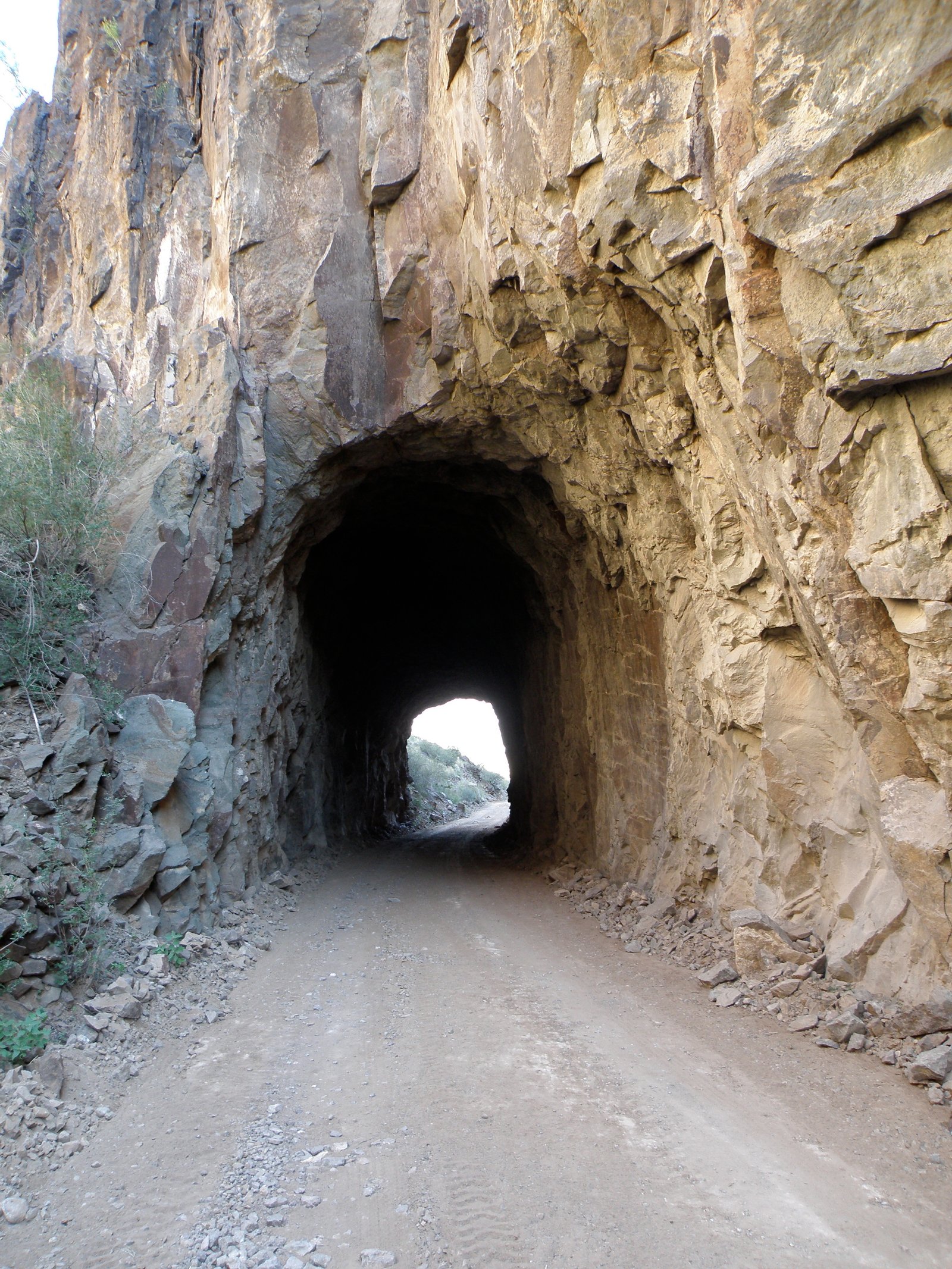TO MY READERS: HOW TO USE THE BLOG
Click Here

ABOVE IS THE RIO GRANDE NORTHERN RAILWAY TUNNEL BLASTED THROUGH BRACKS CANYON IN 1895
In May 1892, the San Carlos Coal Company leased and purchased some 54,000 acres of land in northwest Presidio County, Texas with the intention of mining coal. Because of the remote location of the mine it became necessary to build a 26.25-mile railroad from the Chispa siding on the Southern Pacific Railroad to San Carlos. The Rio Grande Northern Railway Company incorporated in February 1893 with the line being completed three years later. A major part of the construction took place with the blasting though Brack's Canyon one of six railroad tunnels in Texas. During this time, the San Carlos Mining Company commenced mining operations but the coal produced proved to be of varying quality and insufficient quantity. The Rio Grande Northern Railroad was utilized only once to transport a few carloads of coal from the mine in 1896. Mining operations then ceased and the following year, Presidio County Sheriff Den Knight sold the abandoned railroad for unpaid taxes.
For over a hundred years now, the story of the San Carlos Mine and Rio Grande Northern Rail Way has been shrouded in mystery. While the venture was short-lived and ended in failure, it is an important part of Big Bend history that reflects the great optimism felt by the thousands of settlers who came to the region following the coming of the railroads. The 1880's proved to be a pivotal time of economic expansion in the Big Bend. In the early 1880's, John Spencer discovered rich silver ores in the Chinati Mountains near Milton Faver's ranch headquarters setting in motion a boom in mining boom lasted into the early twentieth century. Even more importantly during the early 1880's the Southern Pacific Railroad laid tracks eastward across the sparsely populated desert landscape of the region and the trains started running bringing passengers and freight to and from the outside world. Cattlemen could now ship their livestock to a hugely expanded market. The good grass and cheap land attracted countless ranchers and settlers in search of better times to the Big Bend. By 1885, more than 60,000 cattle grazed in Presidio County. Towns that would become the future trade centers of the region sprang up and prospered. Times were good and optimism ran high.
Little today remains of the Rio Grande Northern and the coal mine with the exception of the Bracks Canyon tunnel, the railroad bed, a trestle and two mineshafts. Following the sale of the railroad, the tracks and ties were torn out. The once bustling mining camp of San Carlos that served as a base of operations to some 300 miners and construction workers sits empty in the desert. Only piles of rubble mark the location of a few jacales where some of the miners lived. Little has been known about the railroad and mine because the surviving records and correspondence of the RGNR and the mine are few.
I first visited the tunnel and San Carlos in the late 1970's and have always been fascinated with the story. For nearly thirty years, I was only able to locate scattered documents that left so many gaps in the story. However, two years ago, I found the papers of Humpries and Company preserved in some thirty dusty boxes in the archives of the El Paso Public Library. Beginning about 1885, Humpries and Company became the largest mercantile in the Big Bend with stores located at Marfa, Shafter, Chispa and San Carlos. The records contain the correspondence of John Humpries who was present when the railroad and mine were being built. It is through his correspondence and the Humpries store records that I have been able to finally tell the whole story.
Born in England, John Humpries was a fascinating Big Bend character that came to Marfa in the town's first years. The former sheriff of Duval County, John Humpries was not a man to be underestimated. In 1883, he wrote I would advise all my friends doing business on the frontier to provide themselves with a No. 10 double barrel shot gun, and keep it loaded with buck shot, where they can get hold of it quickly as I have found it is a good thing to have. I am afraid from the looks of things, we have no chance of protection either from the American or Mexican authorities, and a man must be prepared to defend his property himself or leave the country.
I will present my paper titled "The San Carlos Mine And The Rio Grande Northern Railway" at the Center For Big Bend Studies Annual Conference at Sul Ross University in Alpine on Saturday November 8th. Below is a tentative schedule for the conference.
Gj
2008 Center for Big Bend Studies Conference
November 7 and 8
Sul Ross University Center 2nd Floor, Espino Conference Center
Tentative Presenter Schedule
Session 1: TAP Rock Art
2-3:30 Friday
Chair:
Jamie Hampson
Reeda Peel
Roger Boren
Session 2: Warriors of Color
3:45-5:15 Friday
Chair: Mark Saka
Mary Williams
Harold Sayre
Thomas Phillips
Session 3: Current Cultural Issues in the Big Bend
3:45-5:15 Friday
Chair:
Michael Yoder
Emily Levitt
Geoff Kelley
Session 4: Beyond the Alamo
9:00-10:30 Saturday
Chair: Lynn Whitfield
Robert Reitz
Troy Ainsworth
Holle Humphries
Session 5: Community Rock Art Session
9:00-10:30 Saturday
Chair:
Tim Roberts
William Yeates
Andrew Tegarden
Session 6: Biographies
10:45-12:15 Saturday
Chair:
Judith Parsons
Oliver Osborn
Shirley Caldwell
Session 7: Current TAP Investigations
10:45-12:15 Saturday
Chair: John Seebach
Samuel Cason
Richard Walter
David Keller
Session 8: Mining in the Big Bend
1:30-3:00 Saturday
Chair:
Jaclyn Jeffrey
Claude Hudspeth
Glenn Justice
Session 9: At-large History
1:30-3:00 Saturday
Chair:
Paul Wright
Nancy Hickerson
[ view entry ] ( 5922 views ) | permalink |
<<First <Back | 9 | 10 | 11 | 12 | 13 | 14 | 15 | 16 | 17 | 18 | Next> Last>>